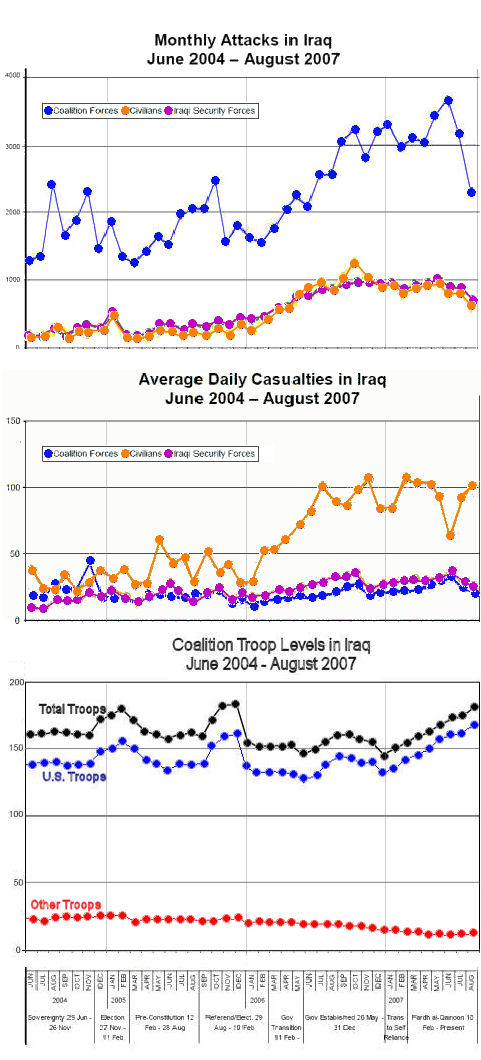
Towards the end of 2004 as the election approached [Iraq’s and 0urs], there were a lot of attacks on our troops [top graph]. Right after our election, we raised the troop levels, presumably in response to the violence [though I’m tempted to speculate that we waited until our election was over]. We didn’t call it a "Surge," but that’s what it was. If you look at the top graph, it worked in the sense that attacks against fell. It was the period when Iraq was drafting their Constitution. As we lowered our troop levels back to the baseline, the attacks against our forces again began to rise as did Iraqi Civilian Casualties, though the number of attacks on Iraqi Forces and Civilians looks to have been little changed.
As the time to transition to Iraqi Self-Rule approached, we again raised troop levels. Again, I don’t recall it being called a "Surge," but that’s what it was. Again, it sort of worked [attacks and Iraqi Civilian Casualties fell]. But the success was short-lived. As soon as we drew down the troops, attacks on all groups began to rise – particularly attacks on our forces. But this time, there was a dramatic rise in Iraqi Civilian Casualties. We all remember the increasing violence and casualties in the first eight or nine months of 2006 as the period when the Administration tried to interpret it as "insurgency" rather than what it was – the flowering of the Iraq Civil War. It looks like it leveled off in the Fall of 2006 [perhaps due to our increasing our troop levels – a "Hump" [July 2006 to Ocxtober 2006] rather than a "Surge" in my estimatation].
It appears we have been raising Troop levels in response to increasing violence all along [since this data-set began some 15 months into the war]. While it has temporarily supressed the attacks and the casualties, that effect has had a short shelf life, and as soon as we try to lower our troop committment, the fighting escalates. It’s also pertinent to look at the gradual fall in our Allies’ troop levels. We obviously make up the slack.
By the end of last year, things were way out of hand. The "Hump" had, at best, only slowed the escalation. Attacks against us had doubled over the year. While the majority of attacks were still against our forces, the attacks against Iraqis had quadrupled. The Iraqi Civilian casualty rate was skyrocketing as the Civil War and ethnosectarian violence progressed. Things weren’t going so well for our Administration at home either. There was a new Democratic Congress, scandals [like the DOJ] were breaking out all over, the American people were getting fed up with the war, Administration Approval Ratings were tanking, our Military was stretched beyond its limit, our Allies were going home, and there was this thing called The Iraq Study Group pointing out how dire our circumstances really were and recommending we admit the truth and start to come home.
So, over the holidays, Bush went into contemplation and emerged with the idea of the Surge. Nothing new there – we’d already tried two Surges and a Hump. But the American people didn’t know that, so let’s do it again. The problem was that our resources were extremely thin, so the Third Surge is more of a "Slider" than a "Fastball" [as you can see on the bottom graph]. And Bush made a bit of a miscalculation. He said we would reevaluate in September. That would have been a decent guess in the past, but not in the face of this "Slow Surge." And there’s something that happened in June. On Petraeus’ grap[h, it’s called the "Surge of Offenses." I can only find it mentioned in Military Reports and don’t understand it – but my guess is that we went on the attack. There’s a spike in the top graph. Our casualties spiked and the Civilian casualties fell [briefly]. My guess is that the slowness of our buildup accounts for Petraeus having to doll up the numbers for his report to Congress. So far, the Surge [the Third Surge] has decreased attacks on our forces, has maybe had a slight effect on the attack on Iraqis, but hasn’t really had any effect on the casualties of Iraqi Citizens.
The Third Surge is nothing new. We’ve used it before. But this time, there are problems. There aren’t enough troops in an all volunteer Army of Reservists to bring it off. And it’s probably too late. The Iraq Civil War has found its rhythm and is probably unstoppable without a massive infusion of Troops. Even with that, one ends up with a situation very much like the one we just intervened in – peace through supressive force like Saddam Hussein ‘s dictatorship.
Sorry, the comment form is closed at this time.